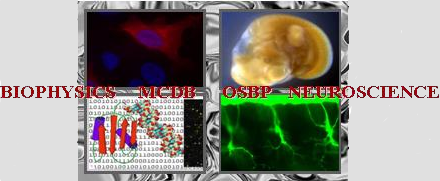Talk abstracts
Talk on Tuesday 05:00-05:15pm submitted by Sarah Sturgill
Troponin I phosphorylation is essential for cardiac reserve
Sarah L. Sturgill (Biophysics), Vikram Shettigar (Dorothy M. Davis Heart and Lung Research Institute, Department of Physiology and Cell Biology, The Ohio State University), Lorien G. Salyer (Dorothy M. Davis Heart and Lung Research Institute, Department of Physiology and Cell Biology, The Ohio State University), Elizabeth A. Brundage (Dorothy M. Davis Heart and Lung Research Institute, Department of Physiology and Cell Biology, The Ohio State University), Brandon J. Biesiadecki (Dorothy M. Davis Heart and Lung Research Institute, Department of Physiology and Cell Biology, The Ohio State University), Mark T. Ziolo (Dorothy M. Davis Heart and Lung Research Institute, Department of Physiology and Cell Biology, The Ohio State University)
Abstract:
In response to an increase in the body’s metabolic demand (e.g., exercise), the heart must increase its pumping performance to meet this demand. To achieve this increase, the heart relies on its cardiac reserve, which is the ability to increase its contractile and diastolic function, but the mechanism(s) responsible for cardiac reserve is poorly understood. The myofilaments are essential for contraction and relaxation with Troponin I (the inhibitory subunit of troponin, TnI) being a key regulatory protein. Studies have shown that TnI serine 23/24 (S23/S24) phosphorylation, the most abundant and important TnI phosphorylation, is a key mechanism for accelerating relaxation by decreasing Ca2+ sensitivity. The role of TnI in cardiac reserve is unknown. For this study, we thoroughly characterized the systolic and diastolic reserve in TnI S23/S24 phosphorylation-null transgenic mice (S23/S24 mutated to alanine, AA mice). Even with increased Ca2+ sensitivity, the AA mice exhibited normal function at resting heart rate and no difference in cardiac structure compared to wildtype. The Bowditch effect (i.e., an increase in contractile function with increasing heart rate) is essential to increase in vivo heart performance. To examine the role TnI S23/S24 phosphorylation in systolic and diastolic reserve, we assessed hemodynamics via left ventricular catheterization on the Bowditch effect by increasing heart rate from 240 to 420 beats per minute. Our data exhibited a clear loss of diastolic and systolic reserve in the AA mice. Since we observed a clear inability to increase systolic and diastolic function in AA mice, we performed speckle tracking echocardiography to more quantitatively investigate AA mice function. We observed that AA mice demonstrated normal systolic radial strain rate and impaired diastolic strain rate at resting heart rate, indicating a mild directional diastolic dysfunction. We conclude that TnI S23/S24 phosphorylation is essential for cardiac reserve by enhancing systolic and diastolic function. A blunted cardiac reserve leads to heart disease making TnI S23/S24 phosphorylation a potential therapeutic strategy.
Keywords: myofilament, cardiac reserve, troponin I
